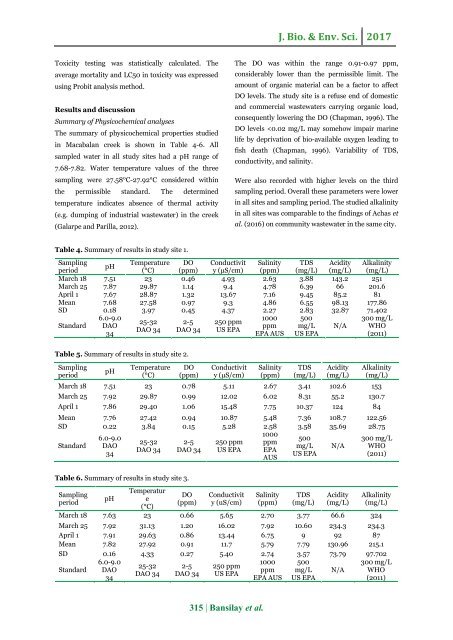Environmental risk assessment of Macabalan creek water in Cagayan de Oro, Philippines
Creek water carries both domestic and commercial wastewater consequently draining organic and inorganic pollutants to coastal water. The present study dealt on the environmental risk assessment of creek water stretching in Macabalan-Cagayan de Oro, Philippines. Selected physicochemical analyses of water samples were carried in both temporal and spatial variations. Risk quotient (RQ), water quality index (WQI), and brine shrimp lethality test (BSL) was employed to draw environmental risk estimate. Overall, dissolved oxygen (DO) concentrations were below the standard set regardless of temporal and spatial variations. Both RQ and WQI showed good statuses on creek water quality despite the low DO. The BSLT similarly indicated a higher concentration for LC50 to be established. The study was preliminary and further monitoring may be essential.
Creek water carries both domestic and commercial wastewater consequently draining organic and inorganic pollutants to coastal water. The present study dealt on the environmental risk assessment of creek water stretching in Macabalan-Cagayan de Oro, Philippines. Selected physicochemical analyses of water samples were carried in both temporal and spatial variations. Risk quotient (RQ), water quality index (WQI), and brine shrimp lethality test (BSL) was employed to draw environmental risk estimate. Overall, dissolved oxygen (DO) concentrations were below the standard set regardless of temporal and spatial variations. Both RQ and WQI showed good statuses on creek water quality despite the low DO. The BSLT similarly indicated a higher concentration for LC50 to be established. The study was preliminary and further monitoring may be essential.
Create successful ePaper yourself
Turn your PDF publications into a flip-book with our unique Google optimized e-Paper software.
J. Bio. & Env. Sci. 2017<br />
Toxicity test<strong>in</strong>g was statistically calculated. The<br />
average mortality and LC50 <strong>in</strong> toxicity was expressed<br />
us<strong>in</strong>g Probit analysis method.<br />
Results and discussion<br />
Summary <strong>of</strong> Physicochemical analyses<br />
The summary <strong>of</strong> physicochemical properties studied<br />
<strong>in</strong> <strong>Macabalan</strong> <strong>creek</strong> is shown <strong>in</strong> Table 4-6. All<br />
sampled <strong>water</strong> <strong>in</strong> all study sites had a pH range <strong>of</strong><br />
7.68-7.82. Water temperature values <strong>of</strong> the three<br />
sampl<strong>in</strong>g were 27.58°C-27.92°C consi<strong>de</strong>red with<strong>in</strong><br />
the permissible standard. The <strong>de</strong>term<strong>in</strong>ed<br />
temperature <strong>in</strong>dicates absence <strong>of</strong> thermal activity<br />
(e.g. dump<strong>in</strong>g <strong>of</strong> <strong>in</strong>dustrial waste<strong>water</strong>) <strong>in</strong> the <strong>creek</strong><br />
(Galarpe and Parilla, 2012).<br />
The DO was with<strong>in</strong> the range 0.91-0.97 ppm,<br />
consi<strong>de</strong>rably lower than the permissible limit. The<br />
amount <strong>of</strong> organic material can be a factor to affect<br />
DO levels. The study site is a refuse end <strong>of</strong> domestic<br />
and commercial waste<strong>water</strong>s carry<strong>in</strong>g organic load,<br />
consequently lower<strong>in</strong>g the DO (Chapman, 1996). The<br />
DO levels


















